Railroads
What do these photos tell you about how trains and train depots were like?
Denver's First Railroad Station
This is a drawing or engraving of Denver's first railroad station. It was made about 1875.
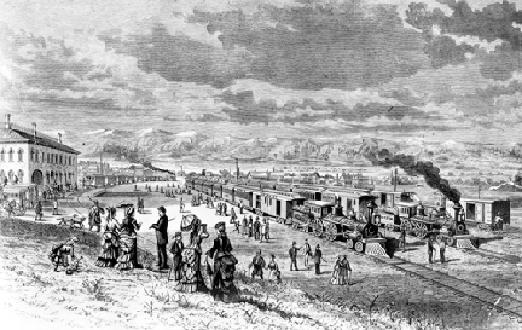
Photo: Denver Public Library, Western History Collection
More About This Topic
The first railroad reached Denver in 1870. It was called the Denver Pacific Railroad. Traveling to Colorado on a railroad car was faster and more comfortable than coming by stagecoach or wagon.
Their Own Words
"As a railroad centre, Denver is fast becoming as important as either Kansas City or Omaha. The new Union Depot, where centre the many tracks of the various roads now extended across the plains to this seat of influence in the West, is one of the largest and handsomest buildings in Denver. . . . Two hundred thousand pieces of baggage were handled at the Union Station in 1886, and the passenger business was larger than ever before."
Source: Edwards Roberts, "The City of Denver," Harper's New Monthly Magazine, (May 1888): 953, 954.
Denver's Union Depot- 1881
The new Union Depot was built in Denver in 1881. It was much larger than the train station shown in the previous photo.
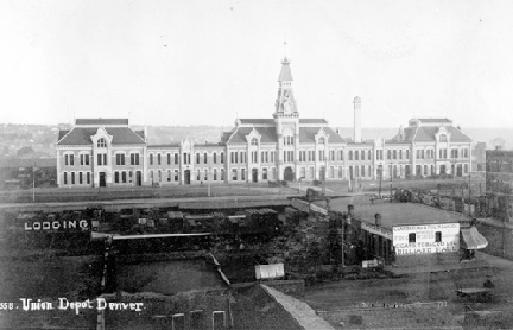
Photo: N/A
More About This Topic
By 1880, several railroads connected Denver to other cities in Colorado and to the east. To provide a connection for these railroads, Denver built a Union Station next to the Platte River. A union station is one used by more than one railroad company.
Their Own Words
"They are building an immense Union R. R. [Railroad] Depot extending clear across 2 Blocks from 16th to 18th Streets, crossing, and blocking 17th Street. This immense structure being built of Stone is at the foot of those Streets near the Platte. An immense building is being erected and well along, at the foot of 16th for heating the City by Steam."
Source: Rezin H. Constant, “Colorado as Seen by a Visitor of 1880,” Colorado Magazine, 12 (May 1935): 111.
Denver's Welcome Arch
This photo shows the Welcome Arch built next to Denver's Union Station. It welcomed people to Denver.
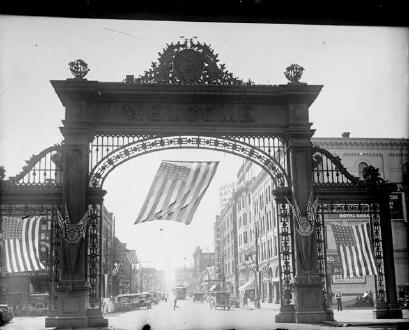
Photo: Denver Public Library, Western History Collection
More About This Topic
One side of the arch at Union Station said "WELCOME." The word MIZPAH was written on the other side. That is a Hebrew greeting that one Denver resident translated as: "The Lord watch between me and thee when we are absent one from another." The photo also shows a trolley car, an early auto, horse-drawn carriages, and a bicycle.
Their Own Words
“It was late afternoon when the train upon which we had come from eastern Kansas stopped at the Denver station—a substantial if not distinguished structure. . . . Passing through the building and emerging upon the taxi stand, we found ourselves confronted by an elaborate gateway of bronze. . . .”
Source: Julian Street, “Hitting a High Spot: Denver,” Collier’s, (November 7, 1914): 16.
"Mizpah"
This photo shows the other side of the Welcome Arch in Denver. It says "MIZPAH." This is a Hebrew greeting that means: "The Lord watch between me and thee, when we are absent one from another."
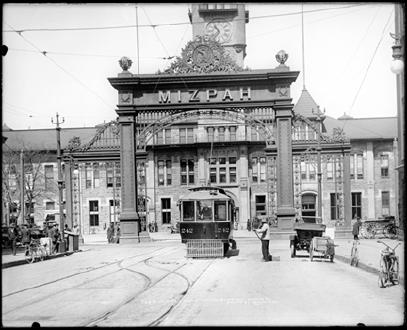
Photo: Denver Public Library, Western History Collection
More About This Topic
This photo shows a trolley car in the middle of the street, an early auto, horse-drawn carriages, and bicycles. It also shows a man sweeping the street with a broom. His street-cleaning cart is parked at the curb behind the auto.
Their Own Words
"[T]he Denver gate [is not] a barrier. Indeed, it is not even a gate, having no doors, but is intended merely as a sort of formal portal to the city—a city proud of its climate, of the mountain scenery nearby, and of its reputation for . . . hospitality. . . . Over the large central arch . . . [one] may read in large letters the word ‘Welcome’; and when later, departing, he approaches the arch from the city side he finds Denver gives him Godspeed with the word ‘Mizpah.’"
Source: Julian Street, “Hitting a High Spot: Denver,” Collier’s, (November 7, 1914): 16.
Grand Junction Railroad Depot
This photo was taken at the train station in Grand Junction. It shows a train pulled by a narrow-gauge locomotive at the station.
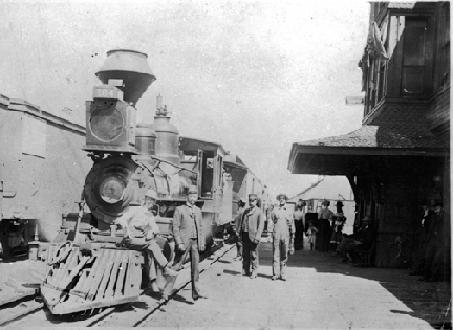
Photo: Colorado Historical Society
More About This Topic
Take a close look at this photo. You will see that the railroad track has four rails. The train in the photo is using the narrow, inside rails. Narrow-gauge locomotives and the cars they pulled were smaller than the regular wide-gauge trains. Many of the early mountain railroads in Colorado had narrow-gauge trains. It was easier for the smaller locomotives and cars to wind through canyons and go over mountains.
Their Own Words
"Gen. Palmer had invented a locomotive with two complete engines on it, boilers and all, so that one would pull and one would push. There were two engineers. When the train, after arriving here, was ready to start back, the other engineer simply took the throttle and the engine would push the cars all the way back to Denver.
"The cars themselves were very small, as well as the engine, and the smokestack looked like the hopper of an old fashioned coffee mill. The whole train looked like a toy compared with the great steel cars and large locomotives of today."
Source: S. M. Buzzard, Dawson Scrapbooks, Vol. 34, p. 81; Colorado Historical Society.
Grand Junction Railroad Depot- 1908
This photo shows the modern railroad station built in Grand Junction in 1908.
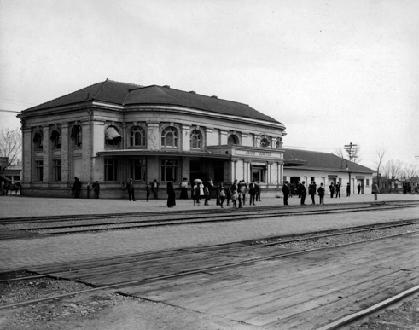
Photo: Colorado Historical Society
More About This Topic
The station in this photo is still in use today.
Their Own Words
"One event of immense importance to the city [of Grand Junction] occurred at this time—the arrival of the first locomotive and the completion of railway communication with the outside world. The coming of the first train to the city, on November 25, 1882, caused great rejoicing among the citizens and filled them with new confidence in the future of the town."
"Tuesday was a day which will be remembered in the history of Grand Junction, as a day which united us by two steel rails with all parts of the United States, and opened up a way for the rapid development of Grand valley’s immense resources. . . . Who can tell what five, ten, or fifteen years may bring forth? Thousands of people all over the United States have read of Grand valley and who have been waiting for an easy access to our valley, will now begin to seek homes in our midst, capitalists will no longer hesitate about placing their money and we may expect a city to spring up as if by magic. . . ."
Source: Grand Junction News, November 25, 1882 quoted in Walker D. Wyman, “Grand Junction’s First Year, 1882,” Colorado Magazine, 13 (July 1936): 132.

